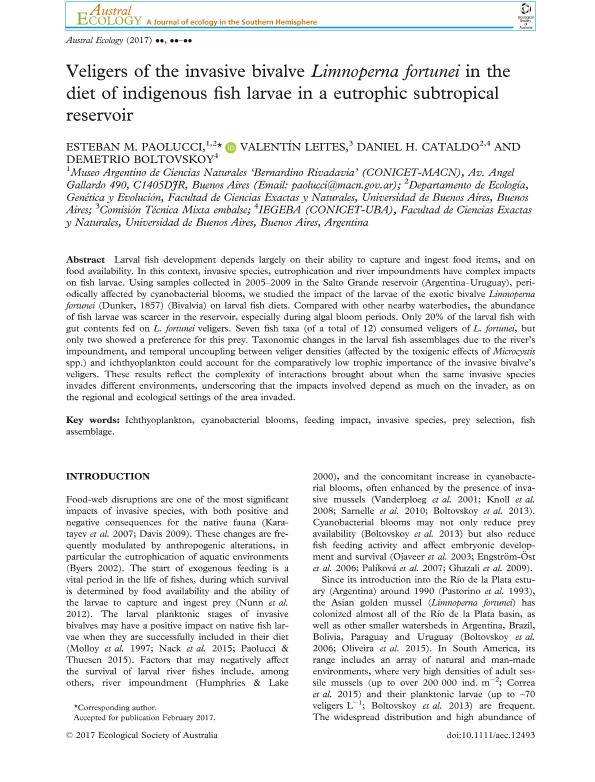Mostrar el registro sencillo del ítem
dc.contributor.author
Paolucci, Esteban Marcelo

dc.contributor.author
Leites, Valentín
dc.contributor.author
Cataldo, Daniel Hugo

dc.contributor.author
Boltovskoy, Demetrio

dc.date.available
2018-11-27T17:59:42Z
dc.date.issued
2017-11
dc.identifier.citation
Paolucci, Esteban Marcelo; Leites, Valentín; Cataldo, Daniel Hugo; Boltovskoy, Demetrio; Veligers of the invasive bivalve Limnoperna fortunei in the diet of indigenous fish larvae in a eutrophic subtropical reservoir; Wiley Blackwell Publishing, Inc; Austral Ecology; 42; 7; 11-2017; 759-771
dc.identifier.issn
1442-9985
dc.identifier.uri
http://hdl.handle.net/11336/65341
dc.description.abstract
Larval fish development depends largely on their ability to capture and ingest food items, and on food availability. In this context, invasive species, eutrophication and river impoundments have complex impacts on fish larvae. Using samples collected in 2005–2009 in the Salto Grande reservoir (Argentina–Uruguay), periodically affected by cyanobacterial blooms, we studied the impact of the larvae of the exotic bivalve Limnoperna fortunei (Dunker, 1857) (Bivalvia) on larval fish diets. Compared with other nearby waterbodies, the abundance of fish larvae was scarcer in the reservoir, especially during algal bloom periods. Only 20% of the larval fish with gut contents fed on L. fortunei veligers. Seven fish taxa (of a total of 12) consumed veligers of L. fortunei, but only two showed a preference for this prey. Taxonomic changes in the larval fish assemblages due to the river's impoundment, and temporal uncoupling between veliger densities (affected by the toxigenic effects of Microcystis spp.) and ichthyoplankton could account for the comparatively low trophic importance of the invasive bivalve's veligers. These results reflect the complexity of interactions brought about when the same invasive species invades different environments, underscoring that the impacts involved depend as much on the invader, as on the regional and ecological settings of the area invaded.
dc.format
application/pdf
dc.language.iso
eng
dc.publisher
Wiley Blackwell Publishing, Inc

dc.rights
info:eu-repo/semantics/openAccess
dc.rights.uri
https://creativecommons.org/licenses/by-nc-sa/2.5/ar/
dc.subject
Cyanobacterial Blooms
dc.subject
Feeding Impact
dc.subject
Fish Assemblage
dc.subject
Ichthyoplankton
dc.subject
Invasive Species
dc.subject
Prey Selection
dc.subject.classification
Otras Ciencias Biológicas

dc.subject.classification
Ciencias Biológicas

dc.subject.classification
CIENCIAS NATURALES Y EXACTAS

dc.title
Veligers of the invasive bivalve Limnoperna fortunei in the diet of indigenous fish larvae in a eutrophic subtropical reservoir
dc.type
info:eu-repo/semantics/article
dc.type
info:ar-repo/semantics/artículo
dc.type
info:eu-repo/semantics/publishedVersion
dc.date.updated
2018-10-23T18:32:14Z
dc.journal.volume
42
dc.journal.number
7
dc.journal.pagination
759-771
dc.journal.pais
Reino Unido

dc.journal.ciudad
Londres
dc.description.fil
Fil: Paolucci, Esteban Marcelo. Consejo Nacional de Investigaciones Científicas y Técnicas. Oficina de Coordinación Administrativa Parque Centenario. Museo Argentino de Ciencias Naturales “Bernardino Rivadavia”; Argentina. Universidad de Buenos Aires. Facultad de Ciencias Exactas y Naturales. Departamento de Ecología, Genética y Evolución; Argentina
dc.description.fil
Fil: Leites, Valentín. Comisión Técnica Mixta Embalse; Argentina
dc.description.fil
Fil: Cataldo, Daniel Hugo. Consejo Nacional de Investigaciones Científicas y Técnicas. Oficina de Coordinación Administrativa Ciudad Universitaria. Instituto de Ecología, Genética y Evolución de Buenos Aires. Universidad de Buenos Aires. Facultad de Ciencias Exactas y Naturales. Instituto de Ecología, Genética y Evolución de Buenos Aires; Argentina. Universidad de Buenos Aires. Facultad de Ciencias Exactas y Naturales. Departamento de Ecología, Genética y Evolución; Argentina
dc.description.fil
Fil: Boltovskoy, Demetrio. Consejo Nacional de Investigaciones Científicas y Técnicas. Oficina de Coordinación Administrativa Ciudad Universitaria. Instituto de Ecología, Genética y Evolución de Buenos Aires. Universidad de Buenos Aires. Facultad de Ciencias Exactas y Naturales. Instituto de Ecología, Genética y Evolución de Buenos Aires; Argentina
dc.journal.title
Austral Ecology

dc.relation.alternativeid
info:eu-repo/semantics/altIdentifier/doi/httpS://dx.doi.org/10.1111/aec.12493
dc.relation.alternativeid
info:eu-repo/semantics/altIdentifier/url/https://onlinelibrary.wiley.com/doi/abs/10.1111/aec.12493
Archivos asociados
